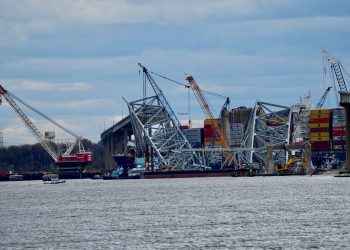According to Reuters, on May 13th, crews in Baltimore conducted controlled explosions to facilitate the removal of a section of the collapsed Francis Scott Key Bridge from the bow of the large container ship that caused the span to topple in March.
As informed, the controlled detonations were conducted by crews in Baltimore to break the collapsed bridge’s truss into smaller sections, allowing salvage operations to remove the twisted metal wreckage using cranes and barges, as reported by the U.S. Army Corps of Engineers. Originally scheduled for 12th May, the work was delayed due to weather conditions.
The U.S. Army Corps of Engineers and state officials have not yet commented on the success of the detonations.
In the early hours of March 26, the vessel named the Dali lost power and collided with a bridge support, causing the span to collapse into the Patapsco River, with a significant portion resting on the Dali’s bow. Tragically, six construction workers lost their lives.
Following the accident, four temporary shipping channels were opened, allowing some shipping activities to resume. The Corps aims to fully restore port access by the end of May.
In April, the FBI initiated a criminal investigation into the collapse. Safety investigators recovered the ship’s “black box” recorder, which contains data on its position, speed, heading, radar, bridge audio, radio communications, and alarms.
Significant milestone achieved tonight with controlled explosives successfully detonated helping to break apart the bridge and start to free the Dali vessel.
Incredible work by the entire Unified Command. @USACEBaltimore @USCG pic.twitter.com/vkNZf039cz
— Port of Baltimore (@portofbalt) May 13, 2024
































































